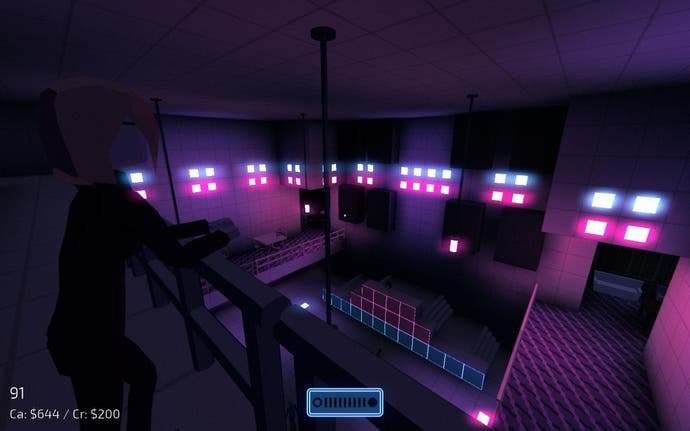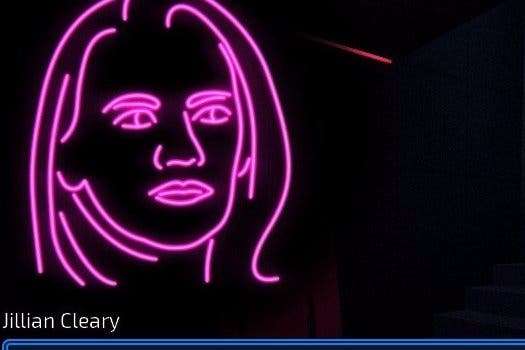Neon Struct review
Tactical espionage abstraction.
Neon Struct is a game built for such a time as this - a surprise, when its elements are so familiar. There's the style, a still-chic blend of 80s cyber fashions that includes Blade Runner hover-cars, Halo Jones' pouting punks, night-scraper skylines, pulsing tubes of blue and pink neon and a synth soundtrack that could perfectly score a Ryan Gosling Drive-by. There's the protagonist, one Jillian Cleary, a conscientious Federal Agent who is betrayed and hunted by the Bureau because, predictably enough, she knows too much.
There's her modus operandi, a blend of stealth influences, most plainly Metal Gear Solid. You must creep through the shadows and crawl through air vents, avoiding the light that may report your presence to the roaming guards (whose routes you watch and note with feline vigilance). You must skulk beneath the swivelling eye of the CCTV camera, hack into computer systems and attempt to complete your objectives without being seen or heard. All of this style and activity is common in video games. All of this could have combined to create a pastiche. And yet, David Pittman's game unfurls with unusual grace and elegance, and breaks its player into rare places of political questioning within the medium.
Rarely does a video game's action and theme align so closely. In Neon Struct, you must evade the watching eyes of your would-be captors, either by hiding in shadows (you can see how visible you are at any given time via a simple gauge, permanently displayed near the centre of the screen) or shutting down surveillance systems. In thematic terms too, this is a game about hiding. You play as an Edward Snowden-type, a former agent of the surveillance state turned public informant, who must survive off-grid, hiding from the "augen der welt" ("eyes of the world") of the game's menacing subtitle.

The stealth is multi-tiered. While in the game's spattering of dialogue choices you are free to protest your belief in the surveillance state if you so choose, this is a game in which, regardless of the political standpoint you assume in game, you're framed for treason by a regime that has plainly over-stepped its powers. It is a timely game in a month when the newly elected Prime Minister of Great Britain said: "For too long we have been a passively tolerant society, saying to our citizens 'As long as you obey the law, we will leave you alone'."
Neon Struct is also counter-cultural in that it is a pacifist's game. While it is possible to render guards unconscious with a blow to the back of the neck (and, like Solid Snake, you may then haul their bodies to a darkened corner) there are no lethal options. There are stim-packs (either collected from the basements of the various businesses you infiltrate across the game's eight missions, or bought from shady salesman on the streets of the various American cities you visit in the downtime between assignments) to make you temporality invisible, or to dampen your footsteps. Likewise, scrambling grenades can disorientate your foes, or take out the lights. In every case evasion is always the preferable option. Your performance rating for each mission will be downgraded if you're detected, set off an alarm, take down a guard, or if a body is discovered.
The missions are ostensibly simplistic (usually you'll have to break into a building, find something or someone, then escape undetected) but from the handful of tools at your disposal luxurious potential arises. There are no route markers or map to guide you through your objectives. You have to listen carefully during the briefing, and then find your own way through the warren-like buildings, constructing a memory map of the places that you have been, reading signage and employing logic to guide you.

Guards have three stages of alertness: they'll look in your direction if they think they heard something, come searching if they think they see something, and bludgeon you if they spot you. Remain in the darkness (you can flick the light switches off without arousing suspicion) and you remain undetectable unless someone happens to bump into you. The stealth is more forgiving than in other games of this ilk, even if it is just as repetitive. Indeed, the interstitial breather scenes are essential to release the tiresome pressure of having to sneak past so many lookouts.
You can pickpocket guards to obtain they keys (more senior targets offer better clearance) but it's also possible to hack some locked doors and security systems. In a joke that doesn't ever get old, you must use the BIT, or 'break-in' tool to bypass the game's security systems by playing quick game of the Atari arcade classic 'Breakout', in which you bounce a ball against a ceiling of disintegrating bricks. Break through the topmost layer of bricks to send the ball off-screen and the system will unlock. The more complex the lock, the more complex the mini-game. It's a witty, silly abstraction that nevertheless proves effective. Tension mounts quickly when you know the next guard is en route and you have only a few seconds to bounce the ball at the right angle.
Neon Struct's greatest achievement though is in its brooding storyline, told through tense phone conversations, brief chats on the streets and, most vividly, through the sense of fear you feel when you're kicked out of a supporting institution of near-omniscient power, to a place of want and hiding. The narrative is told with a light touch (characters have names such as Vinod Chhibber and Director Furtwengler) but it feels weighty and relevant, without tipping into blunt moralising. The best kind of science fiction thriller then: one dressed in the style of the future, but engaged with the pressing issues of the present.










